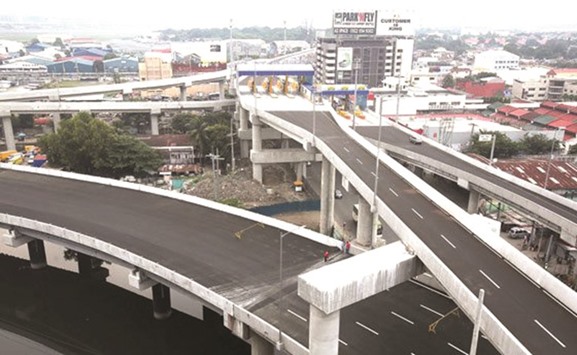After nearly a year of delay, the government and the infrastructure arm of San Miguel Corp, opened on Thursday a portion of the Ninoy Aquino International Expressway (NAIAx) that connects airport terminals to the Metro Manila Skyway and Diosdado Macapagal Boulevard on the Manila Bay reclamation area.
As a treat to motorists, they won’t be charged toll fees for a month, officials said.
“Our countrymen will now feel the benefit of having faster and more direct access to NAIA Terminals 1, 2 and 3,” San Miguel President and Chief Operating Officer Ramon Ang said in a statement, as he thanked national and local government offices and various barangay (villages) affected by the project.
The project is actually Phase 2, with the existing Phase 1 connecting the Skyway to NAIA Terminal 3 and Resorts World Manila. NAIAx Phase 2 has two phases, and Phase 1 connecting Macapagal Boulevard near the Entertainment City to NAIA Terminals 1 and 2 was opened Thursday.
Phase 2, including the portion linking to Terminal 3, will be opened to the public before the end of the year.
Costing P17.9bn ($385.2mn), NAIAx Phase 2 consists of a four-lane, 7.75-kilometre elevated expressway and a 2.22-kilometre at-grade road, traversing Sales Avenue, Andrews Avenue, Paranaque River, MIA Road and Macapagal Boulevard.
The Department of Public Works and Highways said NAIAx would benefit 80,000 motorists daily by significantly reducing average travel time between the Skyway and NAIA Terminal 1 to eight minutes from 24 minutes.
San Miguel expects the project to ease traffic congestion in surrounding cities, and support economic growth in southern Metro Manila.
The project was awarded to San Miguel subsidiary Vertex Tollways Development Inc, with DM Consunji Inc as civil works contractor.
The project covers a 30-year concession period starting from road construction.
Toll fees for the first two years of operation have been pegged at P35 to P45 ($0.75 to $0.97), with adjustments allowed every two years.
The project, among the previous Aquino administration’s big-ticket public-private partnership projects, suffered delays as a result of difficulties in acquiring right of way and the transfer of water, telecommunications and power infrastructure on its path.
International / ASEAN/Philippines
Newly-opened section of expressway to offer faster access to airport

Vehicles headed to the airport and vice-versa can now use the newly-completed section of the elevated expressway that connects Macapagal Avenue and Pagcor Entertainment City to NAIA terminals 1 and 2.
